Integrated Shopping Malls: Effect on Singapore Non-Landed Property
VerifiedAdded on 2023/06/03
|6
|1481
|458
Essay
AI Summary
This essay explores the impact of integrated shopping malls on non-landed private property prices in Singapore. It discusses how various factors, including property cooling measures like the Additional Buyer's Stamp Duty (ABSD), have influenced the real estate market. The analysis reveals that while integrated shopping malls initially contributed to higher property prices, subsequent financial regulations led to a price drop, particularly in centrally located areas. The study also considers the influence of MRT station proximity on property values, suggesting that their presence may not always be a determining factor, especially in areas already well-served by public transport. Ultimately, the essay concludes that environmental factors, social amenities, and population density play a more significant role in determining non-landed private property prices than the presence of integrated shopping malls or MRT stations in Singapore.
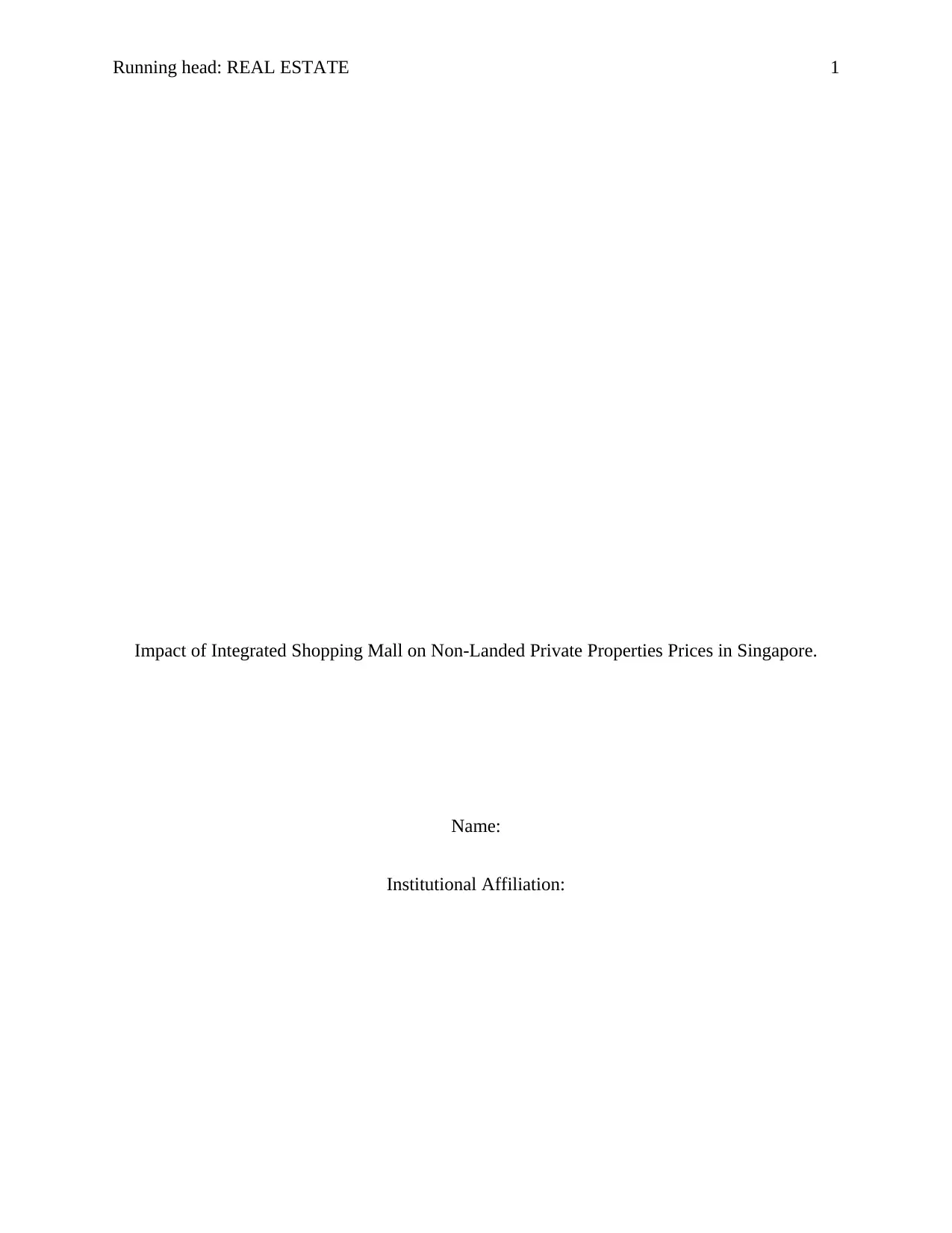
Running head: REAL ESTATE 1
Impact of Integrated Shopping Mall on Non-Landed Private Properties Prices in Singapore.
Name:
Institutional Affiliation:
Impact of Integrated Shopping Mall on Non-Landed Private Properties Prices in Singapore.
Name:
Institutional Affiliation:
Paraphrase This Document
Need a fresh take? Get an instant paraphrase of this document with our AI Paraphraser
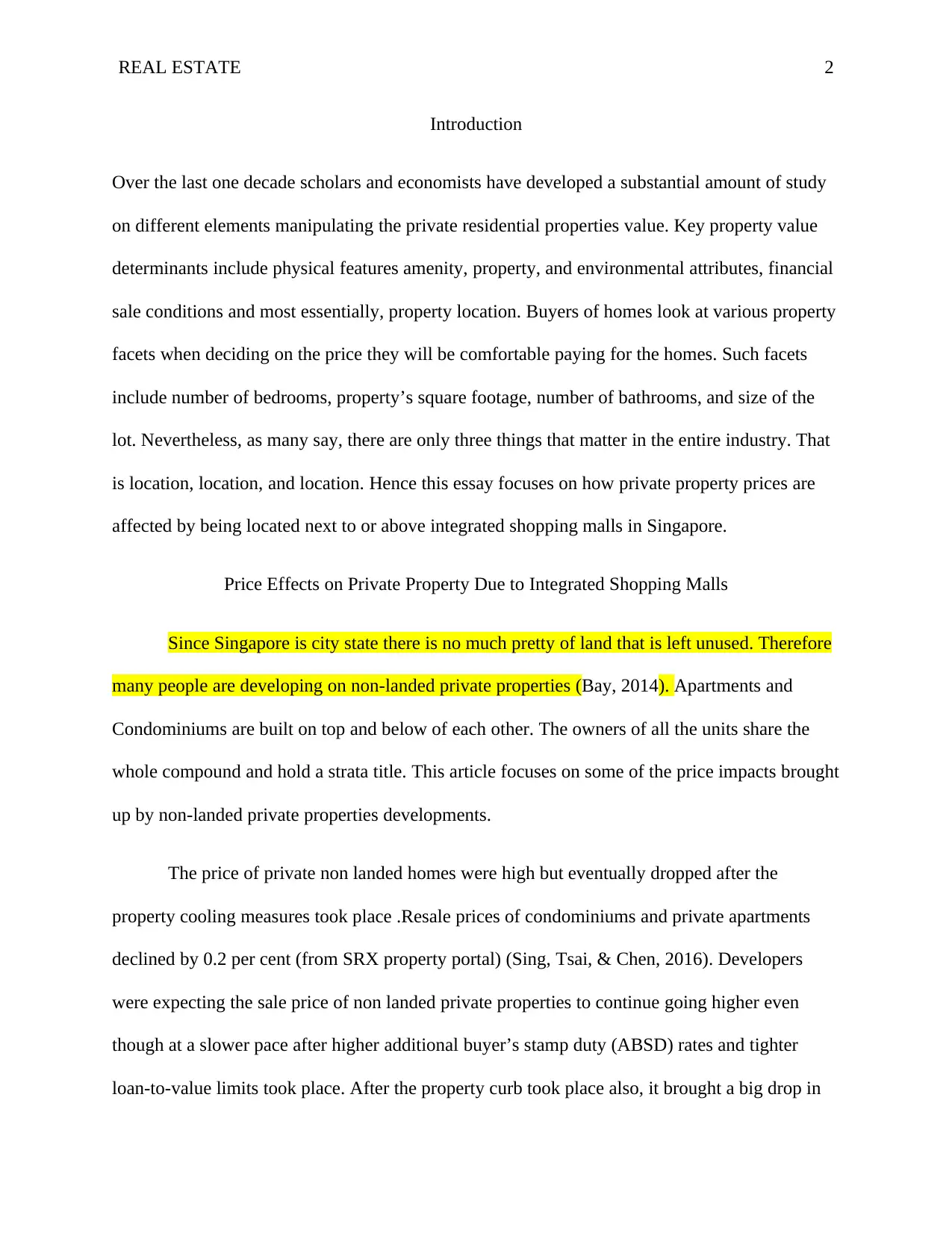
REAL ESTATE 2
Introduction
Over the last one decade scholars and economists have developed a substantial amount of study
on different elements manipulating the private residential properties value. Key property value
determinants include physical features amenity, property, and environmental attributes, financial
sale conditions and most essentially, property location. Buyers of homes look at various property
facets when deciding on the price they will be comfortable paying for the homes. Such facets
include number of bedrooms, property’s square footage, number of bathrooms, and size of the
lot. Nevertheless, as many say, there are only three things that matter in the entire industry. That
is location, location, and location. Hence this essay focuses on how private property prices are
affected by being located next to or above integrated shopping malls in Singapore.
Price Effects on Private Property Due to Integrated Shopping Malls
Since Singapore is city state there is no much pretty of land that is left unused. Therefore
many people are developing on non-landed private properties (Bay, 2014). Apartments and
Condominiums are built on top and below of each other. The owners of all the units share the
whole compound and hold a strata title. This article focuses on some of the price impacts brought
up by non-landed private properties developments.
The price of private non landed homes were high but eventually dropped after the
property cooling measures took place .Resale prices of condominiums and private apartments
declined by 0.2 per cent (from SRX property portal) (Sing, Tsai, & Chen, 2016). Developers
were expecting the sale price of non landed private properties to continue going higher even
though at a slower pace after higher additional buyer’s stamp duty (ABSD) rates and tighter
loan-to-value limits took place. After the property curb took place also, it brought a big drop in
Introduction
Over the last one decade scholars and economists have developed a substantial amount of study
on different elements manipulating the private residential properties value. Key property value
determinants include physical features amenity, property, and environmental attributes, financial
sale conditions and most essentially, property location. Buyers of homes look at various property
facets when deciding on the price they will be comfortable paying for the homes. Such facets
include number of bedrooms, property’s square footage, number of bathrooms, and size of the
lot. Nevertheless, as many say, there are only three things that matter in the entire industry. That
is location, location, and location. Hence this essay focuses on how private property prices are
affected by being located next to or above integrated shopping malls in Singapore.
Price Effects on Private Property Due to Integrated Shopping Malls
Since Singapore is city state there is no much pretty of land that is left unused. Therefore
many people are developing on non-landed private properties (Bay, 2014). Apartments and
Condominiums are built on top and below of each other. The owners of all the units share the
whole compound and hold a strata title. This article focuses on some of the price impacts brought
up by non-landed private properties developments.
The price of private non landed homes were high but eventually dropped after the
property cooling measures took place .Resale prices of condominiums and private apartments
declined by 0.2 per cent (from SRX property portal) (Sing, Tsai, & Chen, 2016). Developers
were expecting the sale price of non landed private properties to continue going higher even
though at a slower pace after higher additional buyer’s stamp duty (ABSD) rates and tighter
loan-to-value limits took place. After the property curb took place also, it brought a big drop in
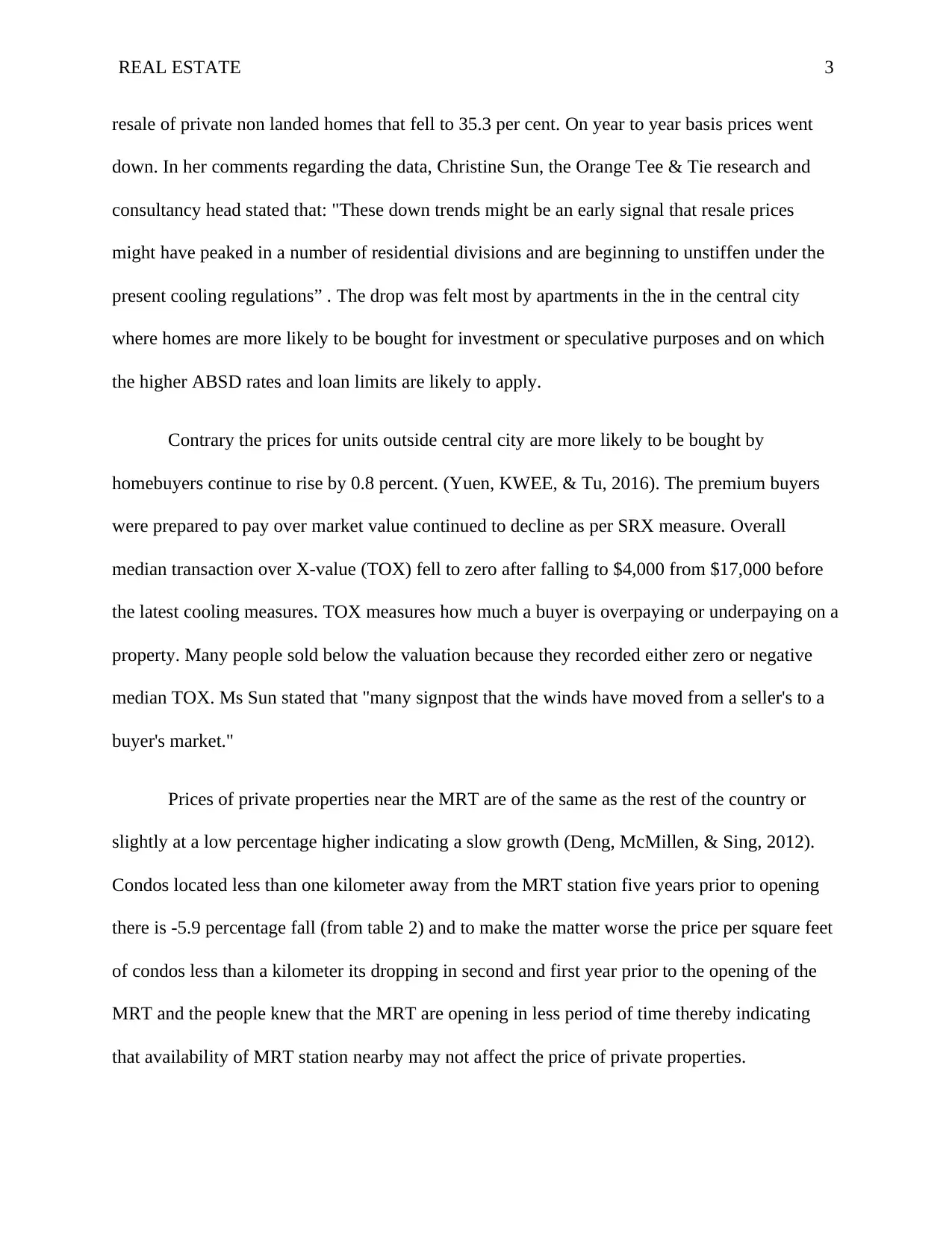
REAL ESTATE 3
resale of private non landed homes that fell to 35.3 per cent. On year to year basis prices went
down. In her comments regarding the data, Christine Sun, the Orange Tee & Tie research and
consultancy head stated that: "These down trends might be an early signal that resale prices
might have peaked in a number of residential divisions and are beginning to unstiffen under the
present cooling regulations” . The drop was felt most by apartments in the in the central city
where homes are more likely to be bought for investment or speculative purposes and on which
the higher ABSD rates and loan limits are likely to apply.
Contrary the prices for units outside central city are more likely to be bought by
homebuyers continue to rise by 0.8 percent. (Yuen, KWEE, & Tu, 2016). The premium buyers
were prepared to pay over market value continued to decline as per SRX measure. Overall
median transaction over X-value (TOX) fell to zero after falling to $4,000 from $17,000 before
the latest cooling measures. TOX measures how much a buyer is overpaying or underpaying on a
property. Many people sold below the valuation because they recorded either zero or negative
median TOX. Ms Sun stated that "many signpost that the winds have moved from a seller's to a
buyer's market."
Prices of private properties near the MRT are of the same as the rest of the country or
slightly at a low percentage higher indicating a slow growth (Deng, McMillen, & Sing, 2012).
Condos located less than one kilometer away from the MRT station five years prior to opening
there is -5.9 percentage fall (from table 2) and to make the matter worse the price per square feet
of condos less than a kilometer its dropping in second and first year prior to the opening of the
MRT and the people knew that the MRT are opening in less period of time thereby indicating
that availability of MRT station nearby may not affect the price of private properties.
resale of private non landed homes that fell to 35.3 per cent. On year to year basis prices went
down. In her comments regarding the data, Christine Sun, the Orange Tee & Tie research and
consultancy head stated that: "These down trends might be an early signal that resale prices
might have peaked in a number of residential divisions and are beginning to unstiffen under the
present cooling regulations” . The drop was felt most by apartments in the in the central city
where homes are more likely to be bought for investment or speculative purposes and on which
the higher ABSD rates and loan limits are likely to apply.
Contrary the prices for units outside central city are more likely to be bought by
homebuyers continue to rise by 0.8 percent. (Yuen, KWEE, & Tu, 2016). The premium buyers
were prepared to pay over market value continued to decline as per SRX measure. Overall
median transaction over X-value (TOX) fell to zero after falling to $4,000 from $17,000 before
the latest cooling measures. TOX measures how much a buyer is overpaying or underpaying on a
property. Many people sold below the valuation because they recorded either zero or negative
median TOX. Ms Sun stated that "many signpost that the winds have moved from a seller's to a
buyer's market."
Prices of private properties near the MRT are of the same as the rest of the country or
slightly at a low percentage higher indicating a slow growth (Deng, McMillen, & Sing, 2012).
Condos located less than one kilometer away from the MRT station five years prior to opening
there is -5.9 percentage fall (from table 2) and to make the matter worse the price per square feet
of condos less than a kilometer its dropping in second and first year prior to the opening of the
MRT and the people knew that the MRT are opening in less period of time thereby indicating
that availability of MRT station nearby may not affect the price of private properties.
⊘ This is a preview!⊘
Do you want full access?
Subscribe today to unlock all pages.

Trusted by 1+ million students worldwide
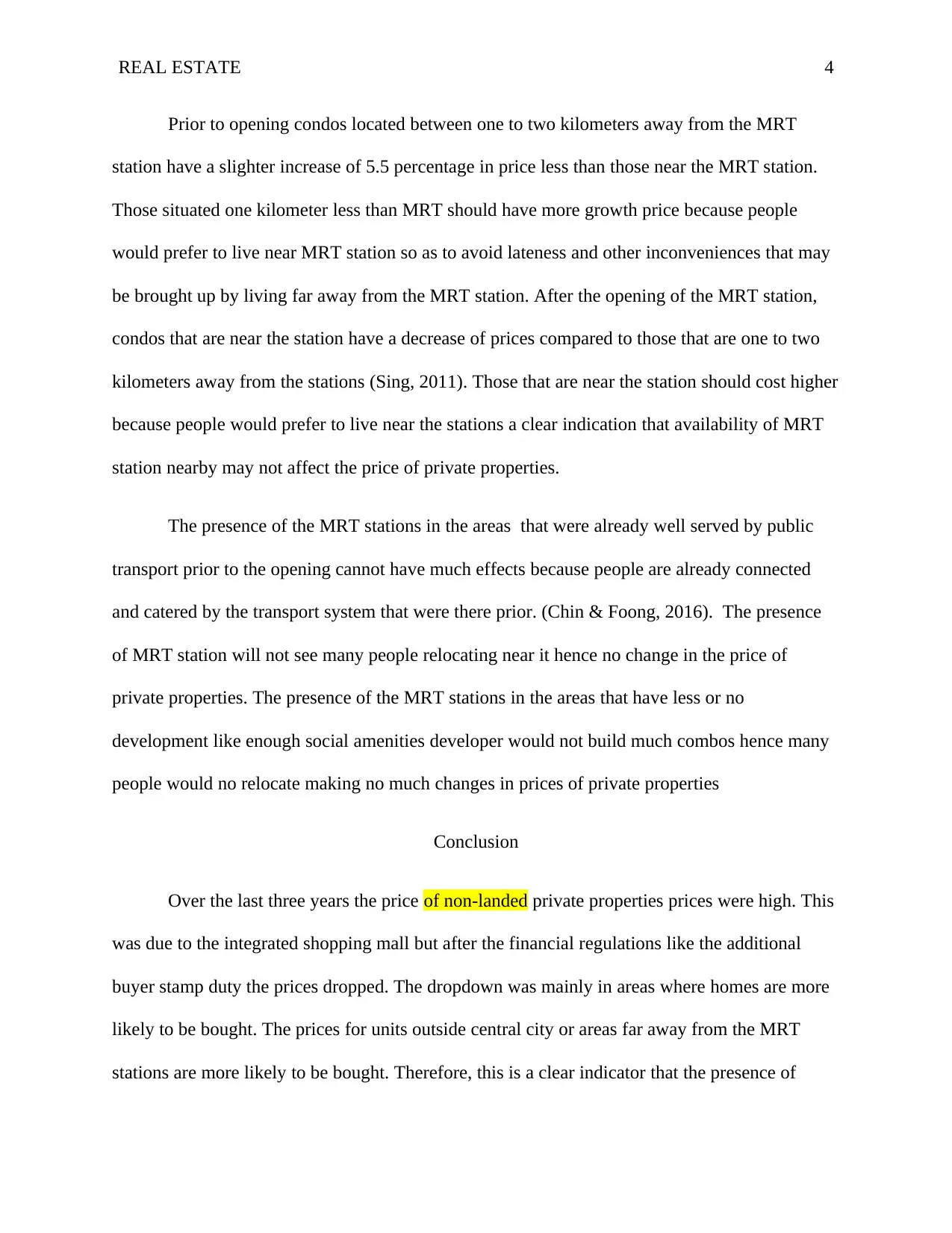
REAL ESTATE 4
Prior to opening condos located between one to two kilometers away from the MRT
station have a slighter increase of 5.5 percentage in price less than those near the MRT station.
Those situated one kilometer less than MRT should have more growth price because people
would prefer to live near MRT station so as to avoid lateness and other inconveniences that may
be brought up by living far away from the MRT station. After the opening of the MRT station,
condos that are near the station have a decrease of prices compared to those that are one to two
kilometers away from the stations (Sing, 2011). Those that are near the station should cost higher
because people would prefer to live near the stations a clear indication that availability of MRT
station nearby may not affect the price of private properties.
The presence of the MRT stations in the areas that were already well served by public
transport prior to the opening cannot have much effects because people are already connected
and catered by the transport system that were there prior. (Chin & Foong, 2016). The presence
of MRT station will not see many people relocating near it hence no change in the price of
private properties. The presence of the MRT stations in the areas that have less or no
development like enough social amenities developer would not build much combos hence many
people would no relocate making no much changes in prices of private properties
Conclusion
Over the last three years the price of non-landed private properties prices were high. This
was due to the integrated shopping mall but after the financial regulations like the additional
buyer stamp duty the prices dropped. The dropdown was mainly in areas where homes are more
likely to be bought. The prices for units outside central city or areas far away from the MRT
stations are more likely to be bought. Therefore, this is a clear indicator that the presence of
Prior to opening condos located between one to two kilometers away from the MRT
station have a slighter increase of 5.5 percentage in price less than those near the MRT station.
Those situated one kilometer less than MRT should have more growth price because people
would prefer to live near MRT station so as to avoid lateness and other inconveniences that may
be brought up by living far away from the MRT station. After the opening of the MRT station,
condos that are near the station have a decrease of prices compared to those that are one to two
kilometers away from the stations (Sing, 2011). Those that are near the station should cost higher
because people would prefer to live near the stations a clear indication that availability of MRT
station nearby may not affect the price of private properties.
The presence of the MRT stations in the areas that were already well served by public
transport prior to the opening cannot have much effects because people are already connected
and catered by the transport system that were there prior. (Chin & Foong, 2016). The presence
of MRT station will not see many people relocating near it hence no change in the price of
private properties. The presence of the MRT stations in the areas that have less or no
development like enough social amenities developer would not build much combos hence many
people would no relocate making no much changes in prices of private properties
Conclusion
Over the last three years the price of non-landed private properties prices were high. This
was due to the integrated shopping mall but after the financial regulations like the additional
buyer stamp duty the prices dropped. The dropdown was mainly in areas where homes are more
likely to be bought. The prices for units outside central city or areas far away from the MRT
stations are more likely to be bought. Therefore, this is a clear indicator that the presence of
Paraphrase This Document
Need a fresh take? Get an instant paraphrase of this document with our AI Paraphraser

REAL ESTATE 5
condominium and stations may not determine the price of private properties. There are many
environmental factors like location, social necessities and population that contributes largely in
determining the prices of the non-landed private properties than the presence of MRT stations
and integrated shopping mall in the four regions of Singapore.
condominium and stations may not determine the price of private properties. There are many
environmental factors like location, social necessities and population that contributes largely in
determining the prices of the non-landed private properties than the presence of MRT stations
and integrated shopping mall in the four regions of Singapore.
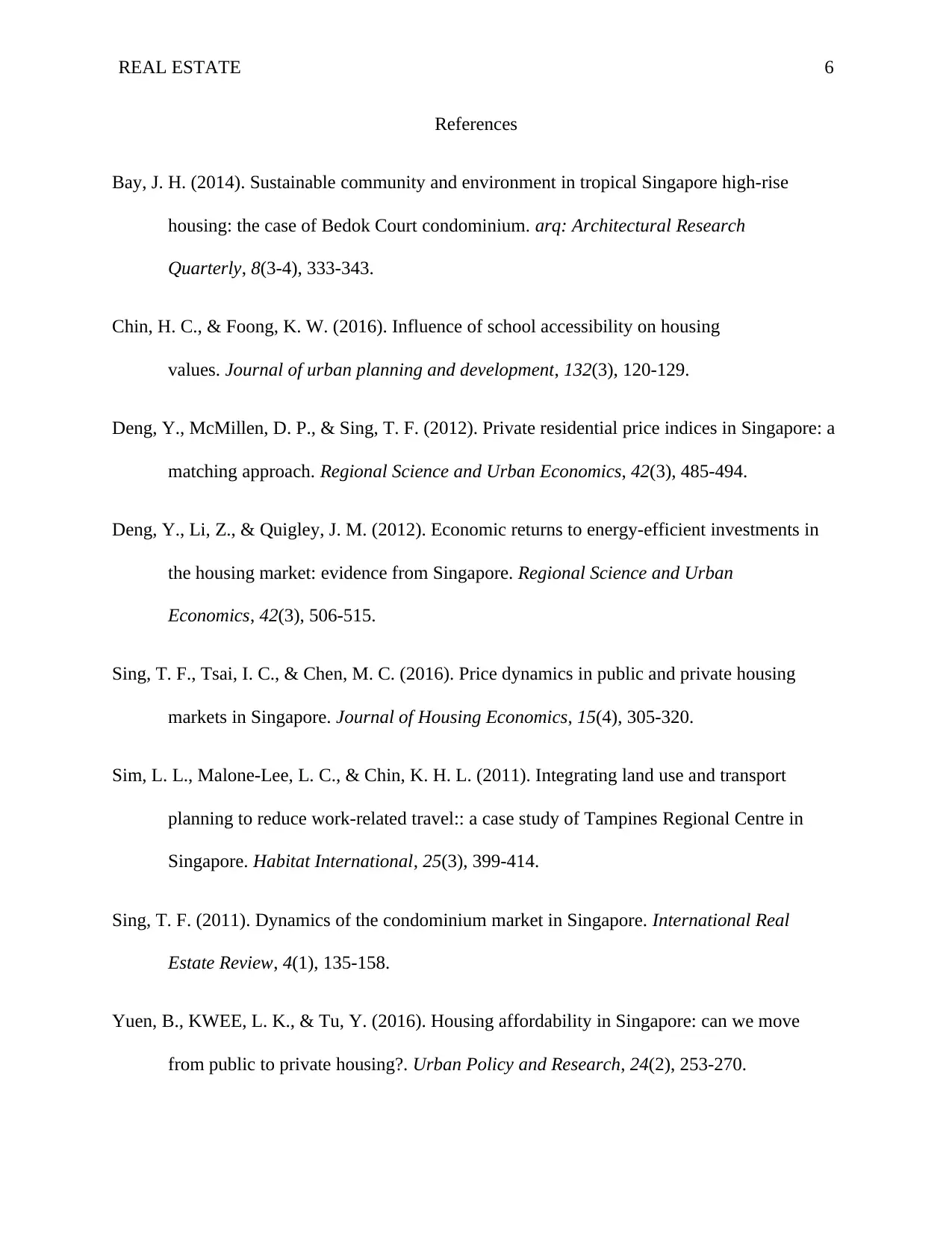
REAL ESTATE 6
References
Bay, J. H. (2014). Sustainable community and environment in tropical Singapore high-rise
housing: the case of Bedok Court condominium. arq: Architectural Research
Quarterly, 8(3-4), 333-343.
Chin, H. C., & Foong, K. W. (2016). Influence of school accessibility on housing
values. Journal of urban planning and development, 132(3), 120-129.
Deng, Y., McMillen, D. P., & Sing, T. F. (2012). Private residential price indices in Singapore: a
matching approach. Regional Science and Urban Economics, 42(3), 485-494.
Deng, Y., Li, Z., & Quigley, J. M. (2012). Economic returns to energy-efficient investments in
the housing market: evidence from Singapore. Regional Science and Urban
Economics, 42(3), 506-515.
Sing, T. F., Tsai, I. C., & Chen, M. C. (2016). Price dynamics in public and private housing
markets in Singapore. Journal of Housing Economics, 15(4), 305-320.
Sim, L. L., Malone-Lee, L. C., & Chin, K. H. L. (2011). Integrating land use and transport
planning to reduce work-related travel:: a case study of Tampines Regional Centre in
Singapore. Habitat International, 25(3), 399-414.
Sing, T. F. (2011). Dynamics of the condominium market in Singapore. International Real
Estate Review, 4(1), 135-158.
Yuen, B., KWEE, L. K., & Tu, Y. (2016). Housing affordability in Singapore: can we move
from public to private housing?. Urban Policy and Research, 24(2), 253-270.
References
Bay, J. H. (2014). Sustainable community and environment in tropical Singapore high-rise
housing: the case of Bedok Court condominium. arq: Architectural Research
Quarterly, 8(3-4), 333-343.
Chin, H. C., & Foong, K. W. (2016). Influence of school accessibility on housing
values. Journal of urban planning and development, 132(3), 120-129.
Deng, Y., McMillen, D. P., & Sing, T. F. (2012). Private residential price indices in Singapore: a
matching approach. Regional Science and Urban Economics, 42(3), 485-494.
Deng, Y., Li, Z., & Quigley, J. M. (2012). Economic returns to energy-efficient investments in
the housing market: evidence from Singapore. Regional Science and Urban
Economics, 42(3), 506-515.
Sing, T. F., Tsai, I. C., & Chen, M. C. (2016). Price dynamics in public and private housing
markets in Singapore. Journal of Housing Economics, 15(4), 305-320.
Sim, L. L., Malone-Lee, L. C., & Chin, K. H. L. (2011). Integrating land use and transport
planning to reduce work-related travel:: a case study of Tampines Regional Centre in
Singapore. Habitat International, 25(3), 399-414.
Sing, T. F. (2011). Dynamics of the condominium market in Singapore. International Real
Estate Review, 4(1), 135-158.
Yuen, B., KWEE, L. K., & Tu, Y. (2016). Housing affordability in Singapore: can we move
from public to private housing?. Urban Policy and Research, 24(2), 253-270.
⊘ This is a preview!⊘
Do you want full access?
Subscribe today to unlock all pages.

Trusted by 1+ million students worldwide
1 out of 6
Your All-in-One AI-Powered Toolkit for Academic Success.
+13062052269
info@desklib.com
Available 24*7 on WhatsApp / Email
![[object Object]](/_next/static/media/star-bottom.7253800d.svg)
Unlock your academic potential
Copyright © 2020–2025 A2Z Services. All Rights Reserved. Developed and managed by ZUCOL.